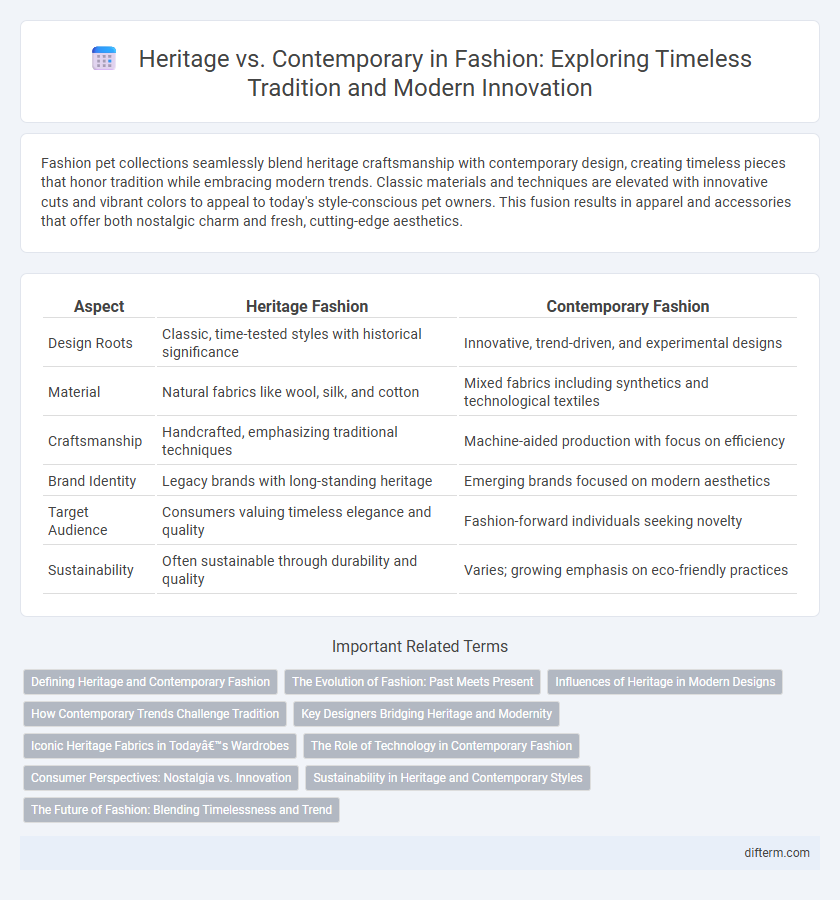Fashion pet collections seamlessly blend heritage craftsmanship with contemporary design, creating timeless pieces that honor tradition while embracing modern trends. Classic materials and techniques are elevated with innovative cuts and vibrant colors to appeal to today's style-conscious pet owners. This fusion results in apparel and accessories that offer both nostalgic charm and fresh, cutting-edge aesthetics.
Table of Comparison
| Aspect | Heritage Fashion | Contemporary Fashion |
|---|---|---|
| Design Roots | Classic, time-tested styles with historical significance | Innovative, trend-driven, and experimental designs |
| Material | Natural fabrics like wool, silk, and cotton | Mixed fabrics including synthetics and technological textiles |
| Craftsmanship | Handcrafted, emphasizing traditional techniques | Machine-aided production with focus on efficiency |
| Brand Identity | Legacy brands with long-standing heritage | Emerging brands focused on modern aesthetics |
| Target Audience | Consumers valuing timeless elegance and quality | Fashion-forward individuals seeking novelty |
| Sustainability | Often sustainable through durability and quality | Varies; growing emphasis on eco-friendly practices |
Defining Heritage and Contemporary Fashion
Heritage fashion embodies traditional craftsmanship, classic designs, and timeless materials passed down through generations, reflecting cultural identity and artisanal expertise. Contemporary fashion prioritizes innovative silhouettes, cutting-edge fabrics, and modern aesthetics aligned with current trends and technological advancements. The dynamic interplay between heritage and contemporary fashion drives industry evolution by blending historical authenticity with progressive creativity.
The Evolution of Fashion: Past Meets Present
Heritage fashion embodies timeless craftsmanship and cultural narratives that shape contemporary design innovation. Modern fashion seamlessly integrates traditional motifs with cutting-edge materials and sustainable practices, reflecting an evolving aesthetic that honors history while embracing forward-thinking creativity. This dynamic interplay between past and present drives the industry's continuous transformation and redefines style for new generations.
Influences of Heritage in Modern Designs
Heritage influences modern fashion by integrating traditional craftsmanship techniques and cultural motifs into contemporary silhouettes, creating a fusion that honors the past while appealing to current trends. Designers draw inspiration from historical textiles, embroidery, and patterns, reinterpreting them with modern materials and innovative cuts to maintain relevance. This blend of legacy and innovation enriches fashion narratives, offering consumers garments that embody both timeless elegance and fresh perspectives.
How Contemporary Trends Challenge Tradition
Contemporary fashion trends challenge tradition by embracing innovation in materials, cuts, and sustainability that contrast with heritage styles rooted in cultural history and craftsmanship. Designers integrate avant-garde technology and global influences, redefining conventional silhouettes and pushing boundaries beyond traditional norms. This evolution creates dynamic dialogues between past and present, transforming fashion into a living art form that reflects modern identity shifts.
Key Designers Bridging Heritage and Modernity
Key designers like Alessandro Michele for Gucci and Virgil Abloh for Louis Vuitton masterfully bridge heritage and modernity by blending traditional craftsmanship with contemporary aesthetics. Their innovative approaches revive classic motifs while infusing streetwear and avant-garde elements, appealing to both legacy brand loyalists and new-generation consumers. This fusion of past and present reshapes the fashion landscape, setting influential trends across global markets.
Iconic Heritage Fabrics in Today’s Wardrobes
Iconic heritage fabrics such as tweed, tartan, and herringbone continue to influence contemporary fashion by blending traditional craftsmanship with modern design. These timeless textiles offer durability and unique textures that elevate today's wardrobes, bridging the gap between classic elegance and current trends. Integrating heritage fabrics into contemporary pieces ensures a sustainable approach, preserving cultural history while appealing to today's style-conscious consumers.
The Role of Technology in Contemporary Fashion
Technology drives innovation in contemporary fashion by enabling advanced materials, 3D printing, and AI-driven design processes that revolutionize how garments are created and customized. While heritage fashion emphasizes craftsmanship and traditional techniques, contemporary brands integrate digital tools to enhance sustainability, fit accuracy, and production speed. The fusion of technology with fashion accelerates the evolution from classic styles toward dynamic, data-informed trends.
Consumer Perspectives: Nostalgia vs. Innovation
Consumers often gravitate toward heritage fashion for its nostalgic value, appreciating timeless craftsmanship and authenticity rooted in brand legacy. In contrast, contemporary fashion appeals to those seeking innovation, cutting-edge design, and alignment with current cultural trends. Balancing these perspectives, successful brands integrate traditional elements with modern aesthetics to meet evolving consumer desires.
Sustainability in Heritage and Contemporary Styles
Heritage fashion emphasizes timeless craftsmanship and durable materials, promoting sustainability through long-lasting quality and reduced waste. Contemporary styles incorporate innovative eco-friendly fabrics and circular design principles, addressing modern environmental challenges. Both approaches contribute to a sustainable fashion future by blending tradition with innovation.
The Future of Fashion: Blending Timelessness and Trend
The future of fashion thrives on blending heritage craftsmanship with contemporary innovation, creating pieces that honor timeless techniques while embracing modern aesthetics. Designers harness traditional fabrics and artisanal methods alongside cutting-edge technology to produce sustainable, versatile collections that resonate across generations. This fusion redefines style by balancing authenticity with trend-forward expressions, ensuring enduring relevance in an ever-evolving industry.
heritage vs contemporary Infographic

 difterm.com
difterm.com